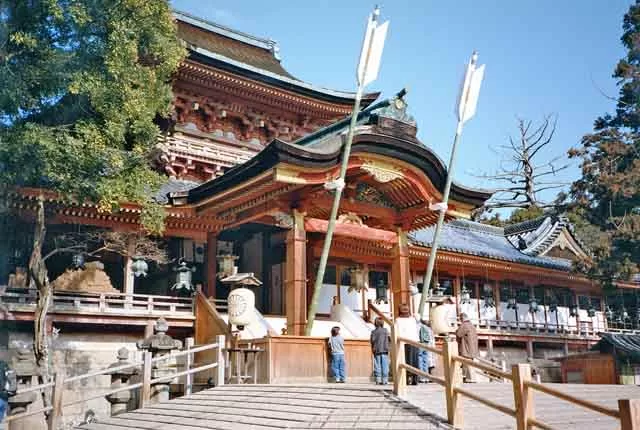Iwashimizu-hachimangu Shrine Hosts Biggest Yakuyoke Festival

Yakuyoke Taisai: A Rich History and Tradition
“Yakuyoke” is a Japanese term for dispelling evil, and “Taisai” refers to grand festival. The Yakuyoke Taisai is a historic event defined by powerful rituals aimed at warding off evil, attracting good luck, and fulfilling various apotropaic wishes. It’s held January 15 to 19 annually at the Iwashimizu-hachimangu Shrine located in Yawata City, south Kyoto.
The Iwashimizu-hachimangu shrine, located approximately 50 minutes from Kyoto station, is renowned as a Yakuyoke shrine, garnering visitors from near and far drawn to its palpable aura of sacredness and ancient tradition. Among the five festival days, January 19th is considered the most important.
Expect an atmosphere replete with intense mysticism and the pervading aroma of burnt talisman as festival-goers wish for luck for the new year. It is considered as one of the most significant Kyoto events in January.
The Shono Shinji Ritual
The festival concludes on January 19 with the awe-striking shono shinji ritual which involves burning old talismans and charms from the previous year. A unique aspect of this ritual is the baking of Japanese rice cake, or mochi, over the purified fire – a symbolic act that intuitively binds attendees to the spiritual essence of the ceremony.
It’s said that eating these mochis brings good luck while helping dispel evil forces that might be lurking around one’s life journey. Naturally, a significant turnout is recorded each year as many individuals are drawn by the chance at spiritual rejuvenation offered by this vibrant yearly festival.
Experiencing Satokagura: Dance & Music
Post-burning of old charms and prayers by priests comes an elegant dance perfomance named Satokagura. During this segment of the festival, expect an exhibition of gracefulness as a female attendant dances to harmonious rhythmic tunes emanating from flutes and drums. Attendees are permitted to capture these moments in photos – so bring your camera!
Limited-Edition Lucky Charm Tag
During the five-day period of Yakuyoke Taisai you can obtain a special tag labelled “Yakuyoke-taisai-fuda”, available exclusively during these days only for those who make prayers (which cost around ¥10,000). This potent charm tag garnered from one of Japan’s most revered apotropaic shrines could potentially fortify one’s life against bad luck in addition to marking fantastic memories of Yakuyoke Taisai.
The Significance of Yakuyoke Kaiun Mochi
The crux of this majestic event hinges significantly upon Yakuyoke-kaiun mochi — purified rice cake made using fire that has burned talismans and charms. This much-anticipated delicacy will be available free for first 1,500 people on January 19th. It’s swung briefly in front of flame for purification before respectfully handed out to attendees lining up in expectation – an act symbolizing not only goodwill but also sustenance for resilience amidst life adversities.
Joka-sanshin Procession: A Commemorative Conclusion
As a fitting end to this grand gathering involving prayer rituals and receiving blessed gifts such as enchanting charm tags or heartwarming mochis comes Joka-sanshin procession.
Named aptly after pure Joka fire used in burning charms at dedication ritual, it’s noted for its noble purpose devoted to dignifying Shinto and Buddhist deities. The commemorative journey where Shinto priests transport this divine fire from main hall up till venue justly signifies an idyllic conclusion — once again affirming that true sanctity doesn’t fade but continues on eternally like Joka fire carried symbolically along historic heritage path.
Visitors aspiring an elementally transformative experience illuminating their spiritual horizon are warmly invited to embrace enigmatic charm inherent in Yakuyoketai Taisai festival coming January —a rendezvous fostering resplendent blend between time-honored traditions augmented by boundless goodwill.
Another interesting event you should see is at Shimogamo Shrine in Kyoto on January 15th for the enchanting Okayu-sai festival, a traditional New Year’s ritual of serving red bean porridge to pray for perfect health and prosperity.